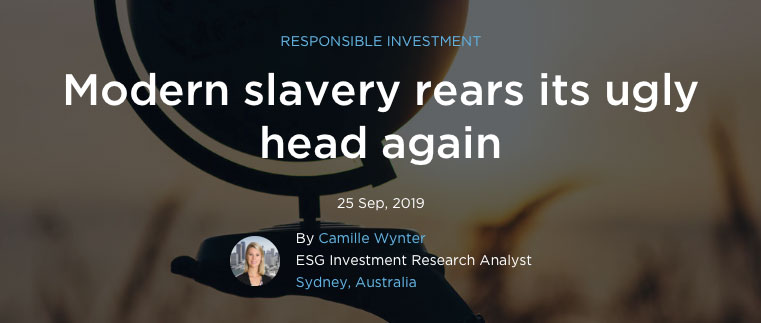
Modern slavery rears it’s ugly head again
– AMP Capital
Once again we are reminded that the clothes we wear carry with them a risk of us unwittingly supporting modern slavery.
A recent current affairs programme in Australia exposed a mass internment camp in the Chinese province of Xinjiang, where it is alleged that Uyghurs, a Turkish-speaking Muslim minority group in China, are being detained and forced to work in garment factories which supply some of the world’s largest clothing brands.
With consumers increasingly demanding cheaper products and faster turnarounds, brands are under pressure and pass this onto their suppliers. As a result, some suppliers cut corners by foregoing the necessary social and environmental checks.
Household names
Several brands sold in Australia (and which are also sold in New Zealand) obtain cotton from Xinjiang. Following the programme, many of these brands immediately started investigations into the suppliers and factories they use in the province.
Unfortunately, the further a company goes down its supply chain the more opaque things become. Subcontracting is common for companies in the apparel sector, especially those producing high volumes at a very low cost.
The risks of modern slavery
The International Labour Organisation estimates there are 40.3 million people in modern slavery globally, including 24.9 million in forced labour1.
As we have communicated previously, labour rights abuses and poor working conditions are not only unethical, they also carry significant investment risks over the longer term to brands and business operations.
The Modern Slavery Act, which came into force in Australia last year, is part of the global response to address the human rights issue of modern slavery. It requires all businesses with revenues over $100 million to disclose details on the actions they are taking to stamp out modern slavery in their operations and supply chains2. This also affects New Zealand businesses carrying on business in Australia.
There are no penalties for failing to comply with the Act, which means it is important that shareholders hold businesses to account and demand they meet their reporting obligations.
Among other things, we have been encouraging companies to:
- Publish a full list of the factories they source from,
- Ensure they have the appropriate internal governance structure to deal with modern slavery risk management,
- Aim to consolidate their supply chain which will allow them more influence and oversight capabilities,
- Train employees to recognise modern slavery, especially those in procurement and supply chain functions and build awareness throughout the organisation,
- Enhance their reporting of suppliers and ethical sourcing to board and management,
- Ensure all their suppliers have the appropriate grievance mechanisms in place so workers can raise issues; and
- Collaborate with other buyers of the same supplier to increase influence.
Lastly, investigations by companies shouldn’t just be focused on modern slavery, and meeting their Modern Slavery Act reporting obligations. Businesses should be investigating all forms of social and environmental abuse which may be lurking in their supply chains.
25th Sep 2019 – Camille Wynter – ESG Investment Research AnalystSydney, Australia

